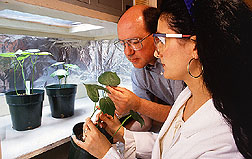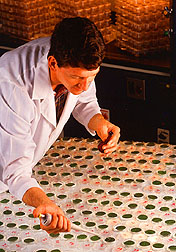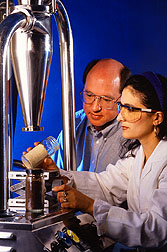Teamwork Boosts Biopesticides' Potential
A new technology-- microencapsulation-- could help useful viruses, bacteria, and other environmentally friendly biopesticides compete with traditional chemical pesticides. Agricultural Research Service scientists and cooperators in Mexico have produced improved formulations that feature economy, reliability, and ease of use.
A hallmark of the new encapsulated formulations is convenience. In the field, farmers will no longer need to add any ingredients besides water. So companies may more easily market their product for air or ground application on a broader array of crops.
Encapsulation is the process of mixing microbes with a matrix-forming material, such as cornstarch, that has been partially gelatinized--that is, heated to enable water absorption. When the cornstarch-microbe mixture is added to water and then dried, the microbes become entrapped in protective particles so small they can barely be seen without a microscope.
Since the early 1970s, amid growing concern for the environment, ARS scientists have sought biological controls for insect pests.
"Encapsulating microbes in starch or other agricultural materials may help establish alternatives to relying on chemical insecticides or transgenic insect toxins that are now in a few crops," says Peter B. Johnsen, director of the agency's National Center for Agricultural Utilization Research (NCAUR) in Peoria, Illinois.
Transgenic insect toxins are proteins produced by plants that have a bioengineered gene from a bacterium such as Bacillus thuringiensis (Bt).
Encapsulated bioinsecticides include not only Bt, but also baculoviruses a group of viruses that cause disease in caterpillars. The viruses begin their infection in the gut of host insects.
ARS entomologist Michael R. McGuire says controlling insects by more than one means may prevent large populations from developing insecticide resistance. For example, microencapsulated baculoviruses may someday be applied to areas planted with both conventional and transgenic cotton. Cotton pests, such as the bollworm and tobacco budworm, that may escape death from Bt toxins can then be killed by the baculoviruses.
These Changes Take Time
Adding microencapsulated bioinsecticide products to the pest-control arsenal has been slower in coming than expected. In 1990, the research team invented a process that used either cornstarch or corn flour in sprayable Bt formulations. The technology worked well in field tests against the European corn borer and was licensed--but was never commercialized.
A difficulty posed by the technology was that there was no single formulation appropriate for different field-spraying equipment and different crops.
"Now we've overcome that Achilles heel of the 1990 process," says McGuire. "We believe our newest process will broaden the marketability of encapsulated biopesticides."
McGuire and co-inventors Patricia Tamez-Guerra, Luis J. Galán-Wong, and Hiram Medrano-Roldán have applied for a patent in Mexico. Last December, they received one of four TECNOS awards presented each year by the three northeast Mexican states, Coahuila, Tamaulipas, and Nuevo León.
In their new process, a sun protectant is incorporated into microencapsulates to retard solar degradation of Bt.
In earlier formulations, adjuvants to boost the formulation's effectiveness were added to encapsulated bioinsecticides in the field. The quantity added was based on how much water was in the mix. Typically, ground applications requiring 100 gallons of water per acre would need much more adjuvant than an aerial application requiring 5 gallons of water per acre.
With the new technology, adjuvants are mixed into formulations as they are manufactured, uniformly bonding them with the starch and Bt, McGuire says. The components remain stable throughout conventional tank mixing and application.
Synergistic Cooperation
New ideas, such as mixing all components during manufacture, were outgrowths of participation by McGuire and other NCAUR scientists in biotechnology workshops for Mexican academia and industry. Included among the students who attended the first workshop in 1992 with their academic advisor Galán-Wong of the Departamento de Microbiología e Immunología at the Universidad Autónoma de Nuevo León in Monterrey, Nuevo León, were Tamez-Guerra and Lilia H. Morales-Ramos. McGuire became an external advisor to both students.
In 1994, a second workshop was held at the Instituto Tecnológico de Durango in Durango. There, Tamez-
Guerra showed McGuire data from her microencapsulated Bt research.
The main ingredient of her formulation was corn flour that had been gelatinized in heated lime-water, as if Teamwork Boosts Biopesticides' Potential
it were to be used in tortillas. She mixed Bt, water, and adjuvants into the pretreated flour. Then she spray-dried the mixture, forming tiny insoluble particles.
McGuire suggested that with further research, the microencapsulation process might become patentable. Through the following year, Tamez-Guerra and her colleagues researched various formulations, spray-drying conditions, particle sizes, sprayability, and attractiveness and lethality of the formulations to insects.
In January 1996, Tamez-Guerra and her colleagues applied for a patent. And since earning her doctorate in May of that year, she has been a visiting foreign scientist at NCAUR under the auspices of USDA's Foreign Agricultural Service.
In Morales-Ramos' collaboration with NCAUR scientists, she took a different approach to bioinsecticide encapsulation.
Her research was on making dry granular formulations that might be dropped into the cupped top leaves, or whorls, of corn before tassels formed, to combat first-generation European corn borers. Rather than using only starch, she experimented with alternative polymers that could come from some of Mexico's lower valued aquacultural and agricultural materials, such as shellfish exoskeletons and citrus wastes. Katiushka Arevalo-Niño also worked on biodegradability of alternative polymers under the mentorship of chemist Syed H. Imam.
Additional students advised by Galán-Wong have attended biotechnology workshops and participated in NCAUR research with other scientist-mentors. Microbiologist Mark A. Jackson is now an external advisor to Myriam Elías Santos and Isela Quintero Zapata, both of whom are exploring economical ways to mass-produce fungal insecticides.--By Ben Hardin, Agricultural Research Service Information Staff.
Michael R. McGuire is at the USDA-ARS National Center for Agricultural Utilization Research, 1815 N. University St., Peoria, IL 61604; phone (309) 681-6595, fax (309) 681-6693.
"Teamwork Boosts Biopesticides' Potential" was published in the June 1998 issue of Agricultural Research magazine. Click here to see this issue's table of contents









